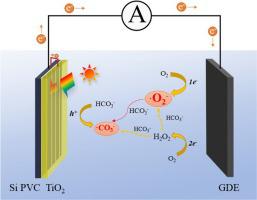Applied Catalysis B: Environment and Energy ( IF 20.2 ) Pub Date : 2020-06-09 , DOI: 10.1016/j.apcatb.2020.119227 Feiyang Chen , Jinhua Li , Ligang Xia , Jiachen Wang , Shuai Chen , Yan Zhang , Jing Bai , Linsen Li , Tingsheng Zhou , Mohammadi Rahim , Qunjie Xu , Baoxue Zhou

|
The treatment of refractory wastewater and energy utilization are challenging environmental issues. Carbonate as the most common anion abounds in the aquatic environment. Here, we proposed a novel method to degrade carbonate-containing wastewater and simultaneous electricity generation via the combined oxidation of CO3− and O2
− radicals. The CO3
− radical was produced by the photoelectrode of TiO2/Si photovoltaic cell with the rear Si photovoltaic cell providing external bias, and the O2
− radical was produced from the generation of H2O2 on a gas diffusion electrode (GDE), and they were both further enhanced from the activation reaction of H2O2 with HCO3− electrolyte. The result showed that a high degradation ratio of 91.97 % was achieved in 120 min for a typical refractory organics of rhodamine b (RhB), which is more than double of that in traditional system by using Pt black as cathode and SO42− as electrolyte. In addition, this system could achieve electricity production with a 28.9 % increase when adding RhB. Moreover, the mechanism of efficient degradation and electricity generation were also studied. The proposed system provides a novel way for organics efficient degradation and simultaneous electricity production in carbonate-containing wastewater.
中文翻译:

协同产生的CO 3 -和O 2 -在一个新颖的光催化燃料电池的基团为含有碳酸盐的废水和同时电力生产的有效氧化
难处理废水的处理和能源利用是具有挑战性的环境问题。碳酸根是最常见的阴离子,存在于水生环境中。在这里,我们通过CO的组合氧化提出了一种新颖的方法来降解含有碳酸盐的废水和同时发电3 -和O 2 -自由基。的CO 3 -是由TiO 2的光电极产生自由基2 / Si的与后硅光伏电池的光伏电池提供外部偏置,和O 2 -自由基是从H的发生所产生2 ö 2上的气体扩散电极(GDE),并且他们都进一步从H的活化反应增强2 ö 2与HCO 3 -电解质。结果表明,若丹明b(RhB)的典型难熔有机物在120分钟内达到91.97%的高降解率,这是使用Pt黑作为阴极和SO 4 2-的传统体系的两倍以上。作为电解质。此外,添加RhB时,该系统可以实现28.9%的发电量。此外,还研究了有效降解和发电的机理。拟议的系统提供了一种新颖的方法,可以有效地降解含碳酸盐废水中的有机物并同时发电。









































 京公网安备 11010802027423号
京公网安备 11010802027423号